


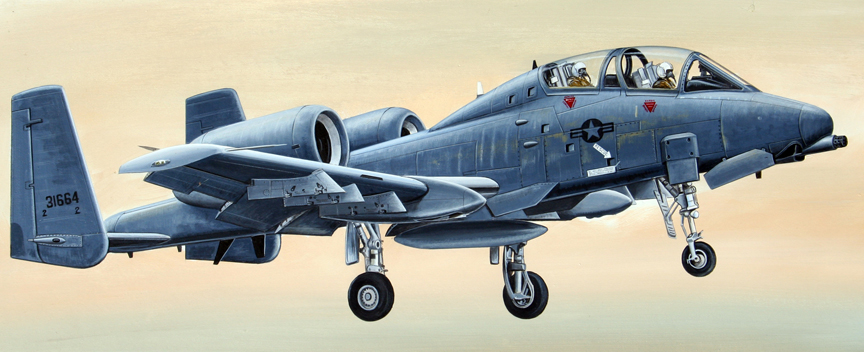
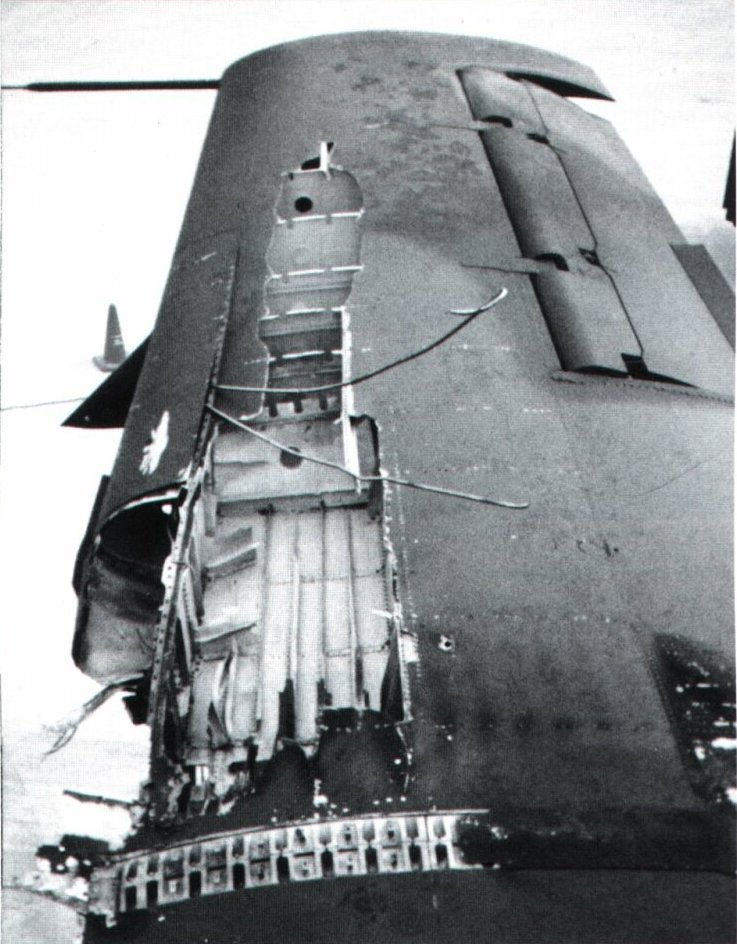

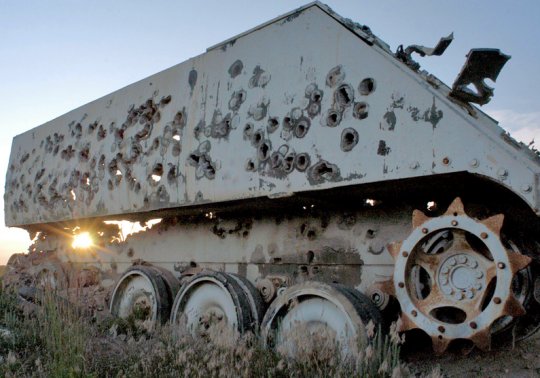



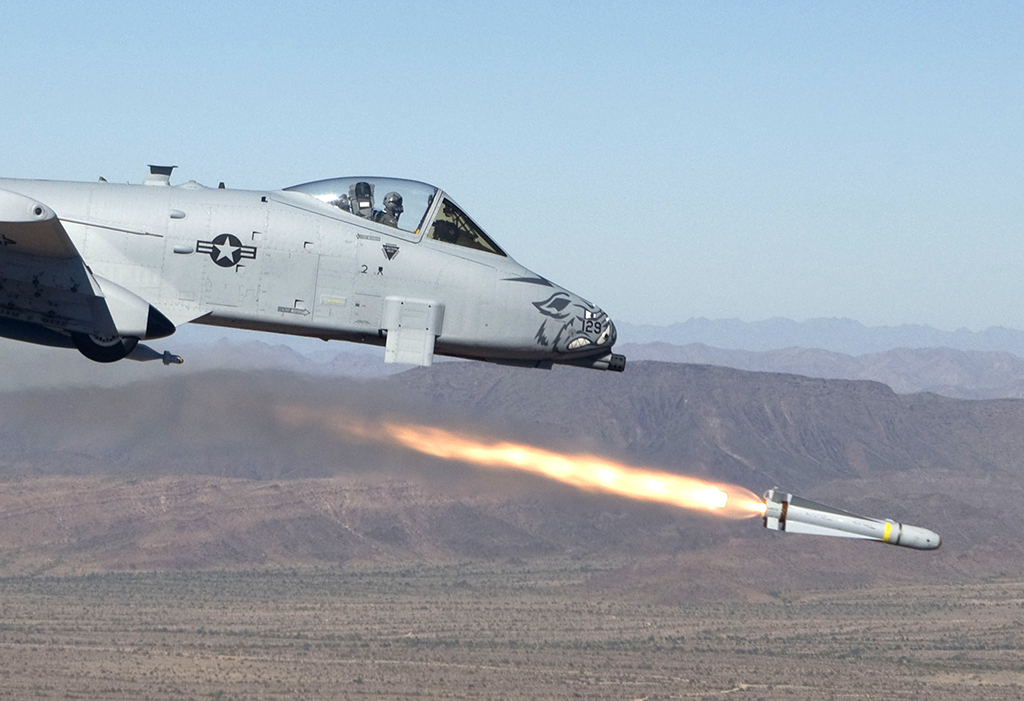





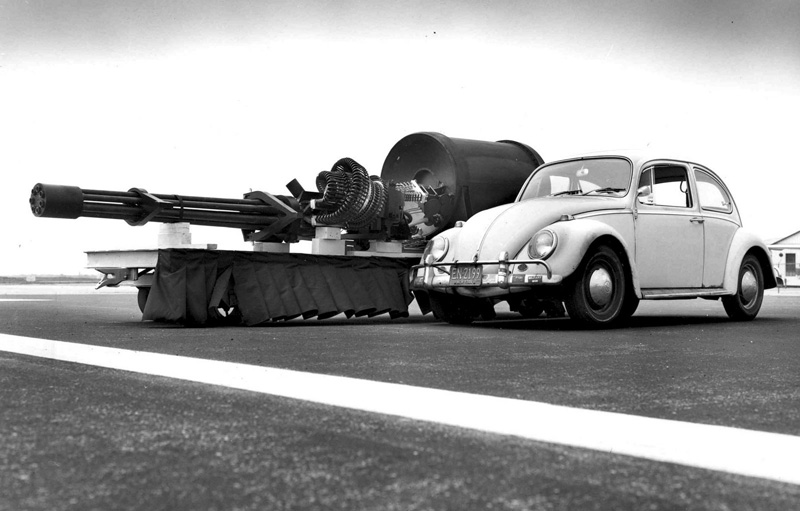




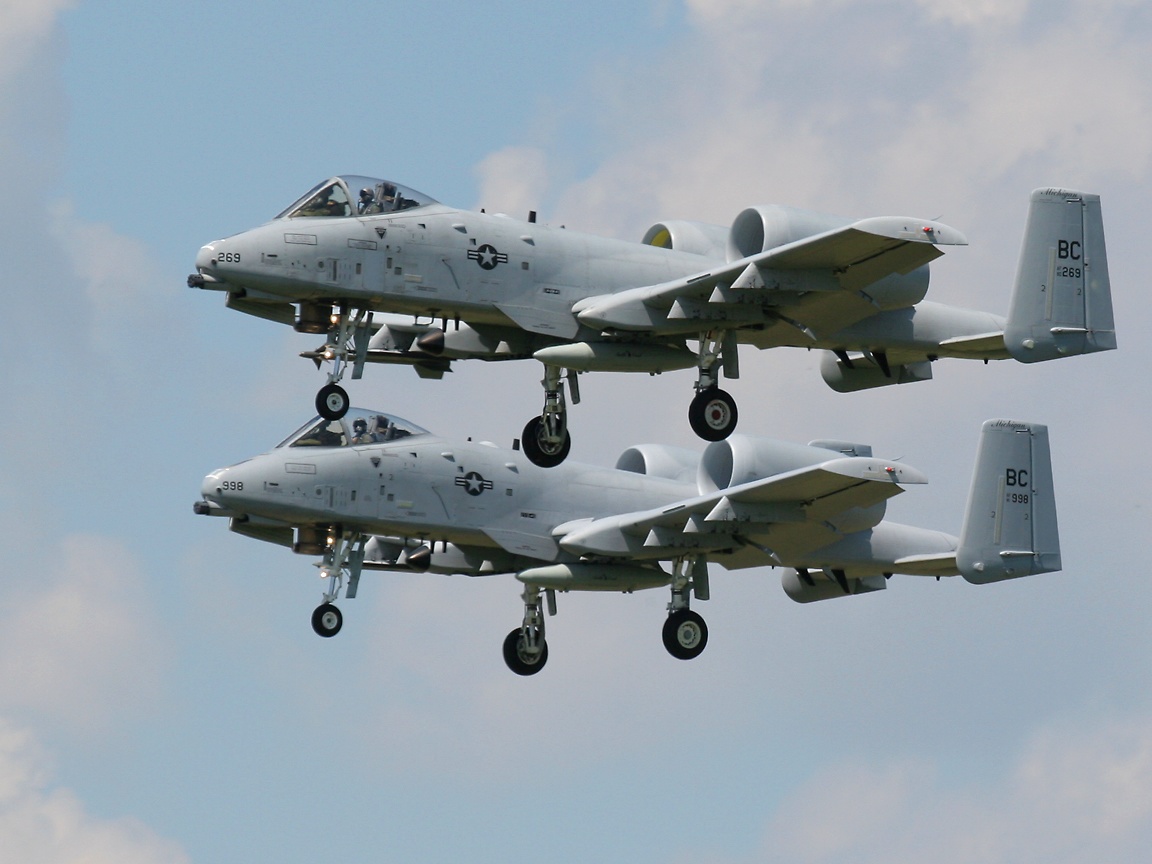

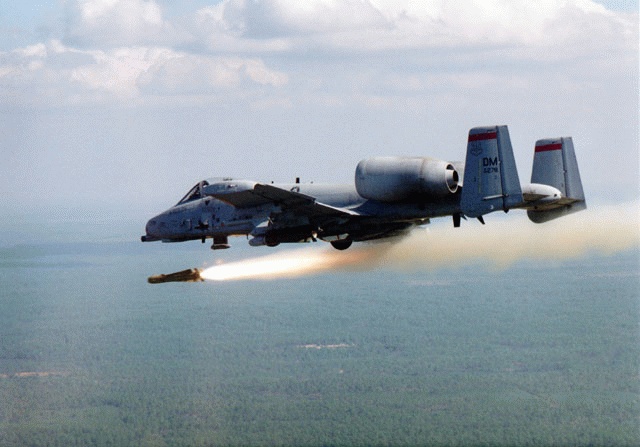


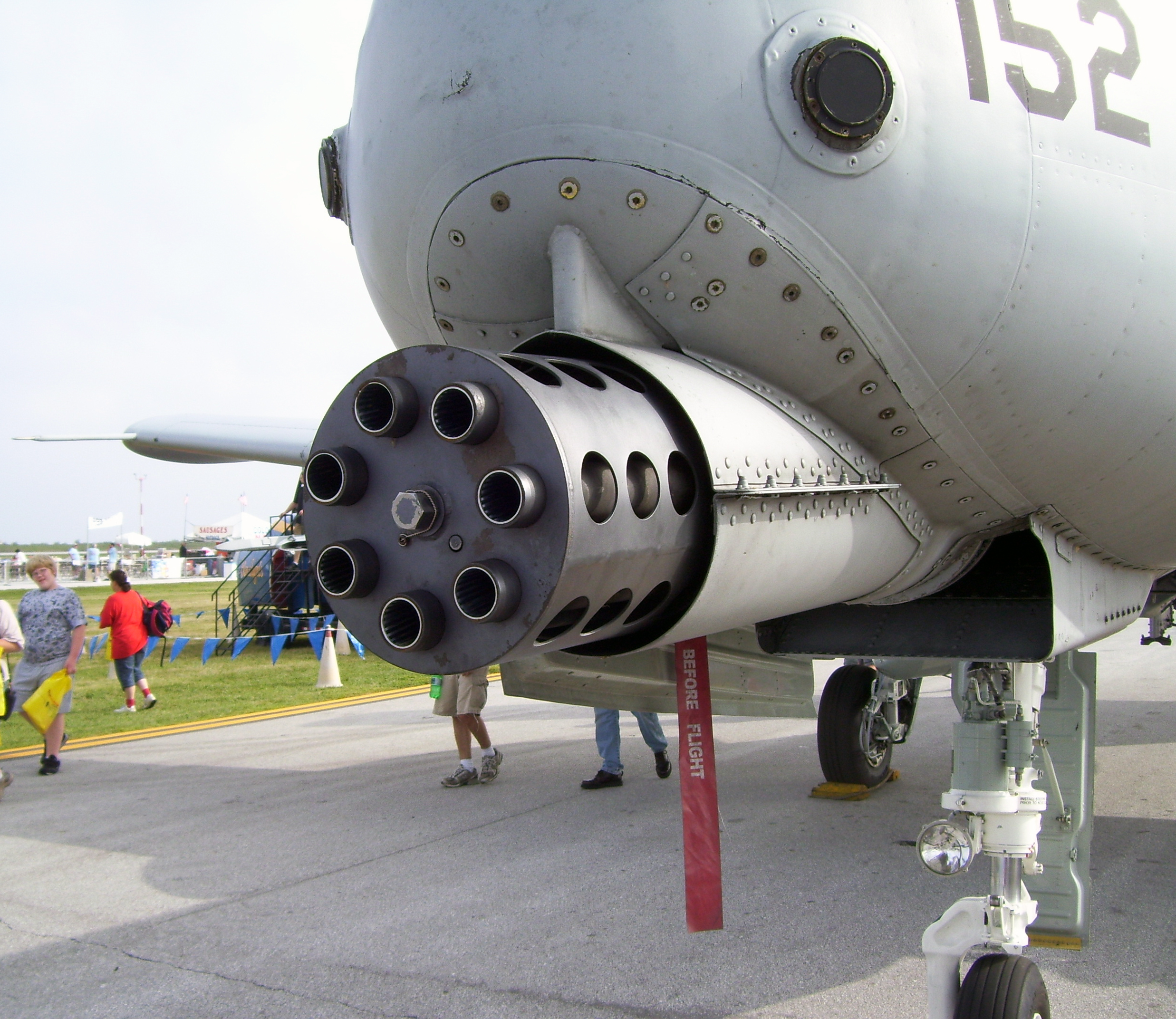

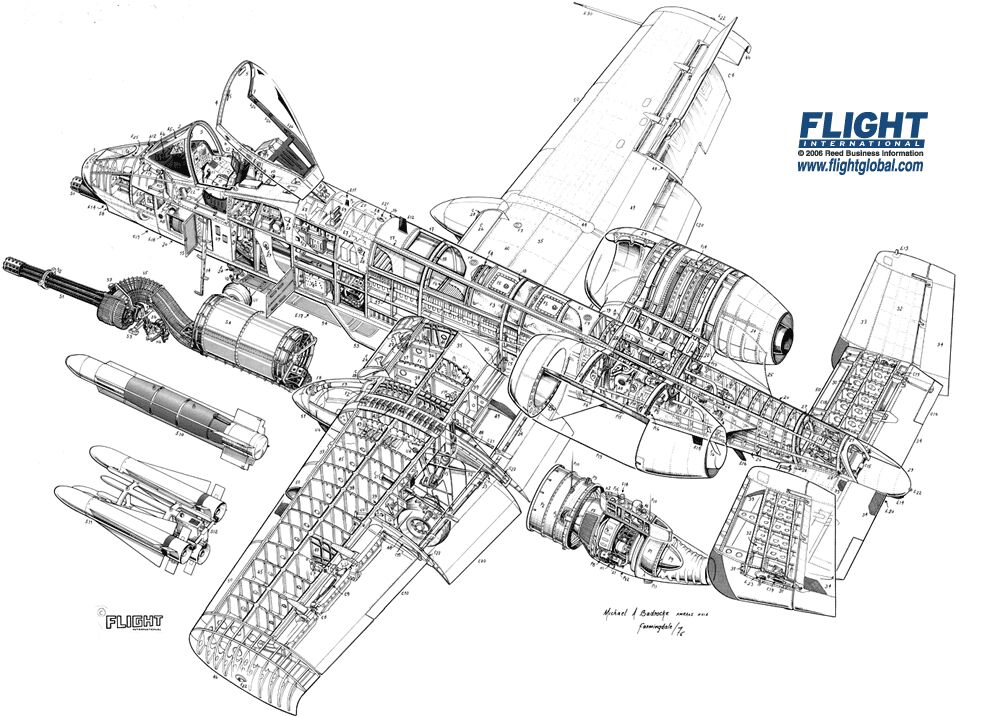

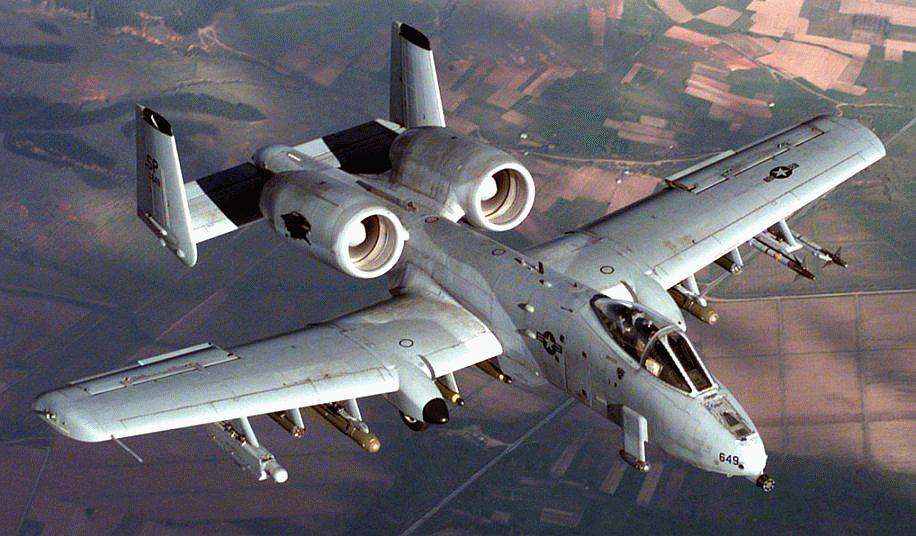


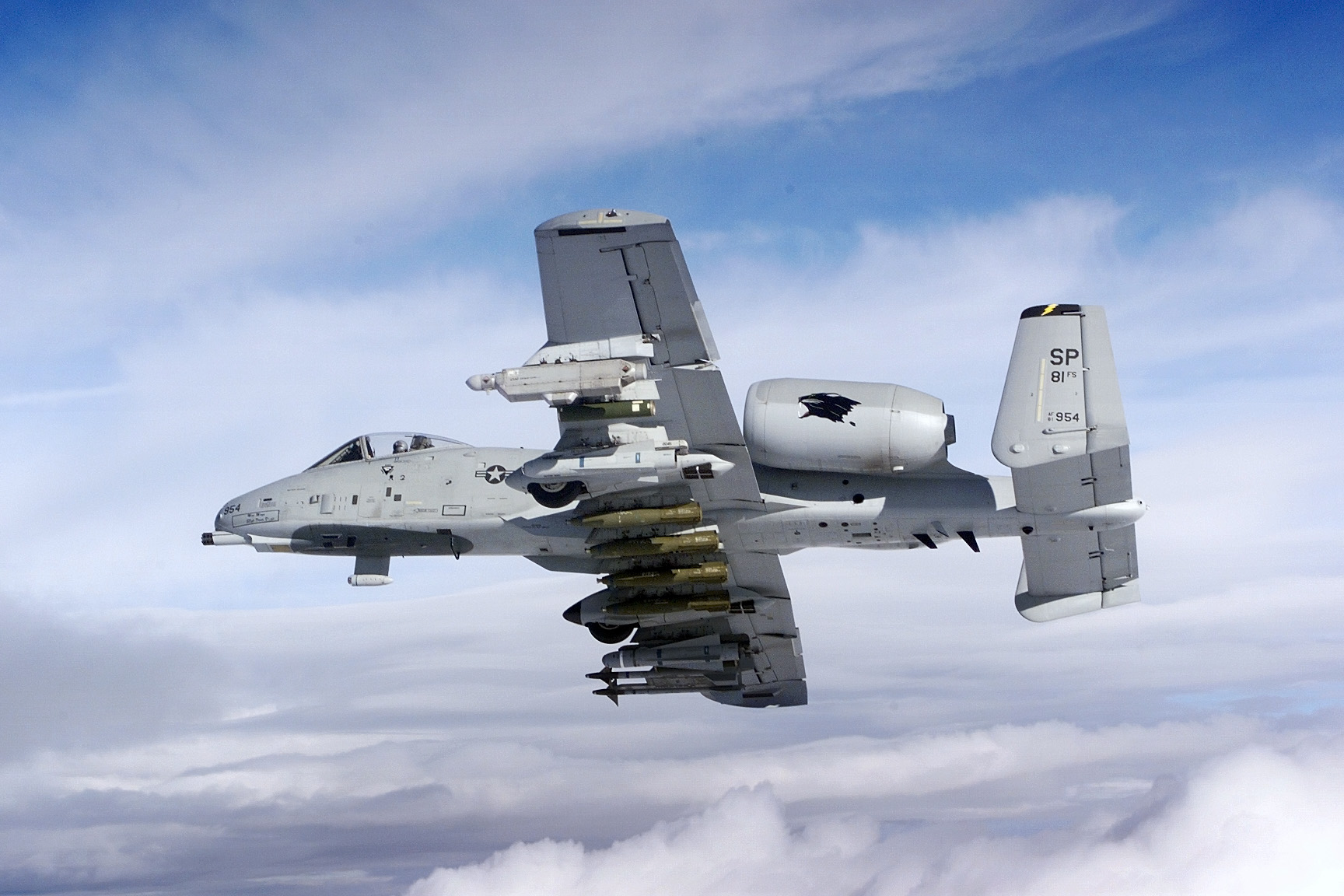


Fairchild Republic A-10 Thunderbolt II
From Wikipedia, the free encyclopedia
"A-10" redirects here. For other uses, see A10.
| A-10 Thunderbolt II | |
|---|---|
 |
|
| An A-10 from the 81st Fighter Squadron, Spangdahlem Air Base, Germany | |
| Role | Fixed-wing close air support, forward air control, and ground-attack aircraft |
| National origin | United States |
| Manufacturer | Fairchild Republic |
| First flight | 10 May 1972 |
| Introduction | March 1977 |
| Status | In service |
| Primary user | United States Air Force |
| Produced | 1972–1984[1] |
| Number built | 716[2] |
| Unit cost |
US$11.8 million (average, 1994 dollars)[3]
|
The A-10 was designed around the GAU-8 Avenger, a 30 mm rotary cannon that is the airplane's primary armament and the heaviest such automatic cannon mounted on an aircraft. The A-10's airframe was designed for survivability, with measures such as 1,200 pounds (540 kg) of titanium armor[4] for protection of the cockpit and aircraft systems that enables the aircraft to continue flying after taking significant damage. The A-10A single-seat variant was the only version built, though one A-10A was converted to the A-10B twin-seat version. In 2005, a program was begun to upgrade A-10A aircraft to the A-10C configuration.
The A-10's official name comes from the Republic P-47 Thunderbolt of World War II, a fighter that was particularly effective at close air support. The A-10 is more commonly known by its nicknames "Warthog" or "Hog". It also has a secondary mission, where it provides airborne forward air control, directing other aircraft in attacks on ground targets. Aircraft used primarily in this role are designated OA-10. With a variety of upgrades and wing replacements, the A-10's service life may be extended to 2028. However, there are proposals to retire it sooner.
Contents
Development
Background
Criticism that the U.S. Air Force did not take close air support (CAS) seriously prompted a few service members to seek a specialized attack aircraft.[5][6] In the Vietnam War, large numbers of ground-attack aircraft were shot down by small arms, surface-to-air missiles, and low-level anti-aircraft gunfire, prompting the development of an aircraft better able to survive such weapons. In addition, the UH-1 Iroquois and AH-1 Cobra helicopters of the day, which USAF commanders had said should handle close air support, were ill-suited for use against armor, carrying only anti-personnel machine guns and unguided rockets meant for soft targets. Fast jets such as the F-100 Super Sabre, F-105 Thunderchief and F-4 Phantom II proved for the most part to be ineffective for close air support because their high speed did not allow pilots enough time to get an accurate fix on ground targets and they lacked sufficient loiter time. The effective, but aging, Korean War era A-1 Skyraider was the USAF's primary close air support aircraft.[7][8]A-X program
In 1966, the USAF formed the Attack Experimental (A-X) program office.[9] On 6 March 1967, the Air Force released a request for information to 21 defense contractors for the A-X. The objective was to create a design study for a low-cost attack aircraft.[6] In 1969, the Secretary of the Air Force asked Pierre Sprey to write the detailed specifications for the proposed A-X project. However, his initial involvement was kept secret because of Sprey's earlier controversial involvement in the F-X project.[6] Sprey's discussions with A-1 Skyraider pilots operating in Vietnam and analysis of aircraft currently used in the role indicated the ideal aircraft should have long loiter time, low-speed maneuverability, massive cannon firepower, and extreme survivability;[6] an aircraft that had the best elements of the Ilyushin Il-2, Henschel Hs 129, and Skyraider. The specifications also demanded that each aircraft cost less than $3 million.[6] Sprey required that the biography of World War II attack pilot Hans-Ulrich Rudel be read by people on the A-X program.[10]In May 1970, the USAF issued a modified and much more detailed request for proposals (RFP) for the aircraft. The threat of Soviet armored forces and all-weather attack operations had become more serious. Now included in the requirements was that the aircraft would be designed specifically for the 30 mm cannon. The RFP also specified an aircraft with a maximum speed of 460 mph (400 kn; 740 km/h), takeoff distance of 4,000 feet (1,200 m), external load of 16,000 pounds (7,300 kg), 285-mile (460 km) mission radius, and a unit cost of US$1.4 million.[11] The A-X would be the first Air Force aircraft designed exclusively for close air support.[12] During this time, a separate RFP was released for A-X's 30 mm cannon with requirements for a high rate of fire (4,000 round/minute) and a high muzzle velocity.[13] Six companies submitted aircraft proposals to the USAF, with Northrop and Fairchild Republic selected to build prototypes: the YA-9A and YA-10A, respectively. General Electric and Philco-Ford were selected to build and test GAU-8 cannon prototypes.[14]
The YA-10A was built in Hagerstown, Maryland and first flew on 10 May 1972. After trials and a fly-off against the YA-9A, the Air Force announced its selection of Fairchild-Republic's YA-10A on 18 January 1973 for production.[15] General Electric was selected to build the GAU-8 cannon in June 1973.[16] The YA-10 had an additional fly-off in 1974 against the Ling-Temco-Vought A-7D Corsair II, the principal Air Force attack aircraft at the time, in order to prove the need to purchase a new attack aircraft. The first production A-10 flew in October 1975, and deliveries to the Air Force commenced in March 1976. In total, 715 airplanes were produced, the last delivered in 1984.[17]
One experimental two-seat A-10 Night Adverse Weather (N/AW) version was built by converting an A-10A.[18] The N/AW was developed by Fairchild from the first Demonstration Testing and Evaluation (DT&E) A-10 for consideration by the USAF. It included a second seat for a weapons system officer responsible for electronic countermeasures (ECM), navigation and target acquisition. The N/AW version did not interest the USAF or export customers. The two-seat trainer version was ordered by the Air Force in 1981, but funding was canceled by U.S. Congress and the jet was not produced.[19] The only two-seat A-10 built now resides at Edwards Air Force Base's Flight Test Center Museum.[20]
Upgrades
The A-10 has received many upgrades over the years. From 1978 onwards, the Pave Penny laser receiver pod was adopted, which receives reflected laser radiation from laser designators for faster and more accurate target identification.[21][22] The A-10 began receiving an inertial navigation system in 1980.[23] The Low-Altitude Safety and Targeting Enhancement (LASTE) upgrade provided computerized weapon-aiming equipment, an autopilot, and a ground-collision warning system. The A-10 is compatible with night vision goggles for low-light operation. In 1999, aircraft began receiving Global Positioning System navigation systems and a multi-function display.[24] The LASTE system was upgraded with Integrated Flight & Fire Control Computers (IFFCC).[25]The A-10 is receiving a service life extension program (SLEP) upgrade with many receiving new wings.[29] The service life of the re-winged aircraft is extended to 2040. A contract to build as many as 242 new A-10 wing sets was awarded to Boeing in June 2007.[30] Two A-10s flew in November 2011 with the new wing installed. On 4 September 2013, the Air Force awarded Boeing a follow-on contract of $212 million for 56 replacement wings for the A-10, bring the total on order to 173. The wings will improve mission readiness, decrease maintenance costs, and keep the type operational into 2035.[31] As part of plans to retire the A-10, the Air Force is considering stopping work on the wing replacement program, which would save an additional $500 million along with the total saving of retiring the fleet.[32] Even if the Air Force kept the 42 A-10s that already underwent wing replacement and divested the rest of the fleet, the savings would only be $1 billion compared to $4.2 billion saved by divesting the whole fleet.[33]
In 2012, Air Combat Command requested the testing of a 600-gallon external fuel tank which would extend the A-10's loitering time by 45–60 minutes; flight testing of such a tank was conducted in 1997, but did not involve combat evaluation. Over 30 flight tests were conducted by the 40th Flight Test Squadron to gather data on the aircraft's handling characteristics and performance across different load configurations. The tank slightly reduced stability in the yaw axis, however there is no decrease in aircraft tracking performance.[34]
In July 2010, the USAF issued Raytheon a contract to integrate a Helmet Mounted Integrated Targeting (HMIT) system onto A-10Cs.[27] The Gentex Corporation Scorpion Helmet Mounted Cueing System (HMCS) was also evaluated.[35] In February 2014, SoAF Deborah Lee James ordered that development of Suite 8 software upgrade continue, in response to Congressional pressure. Software upgrades were originally to be ceased due to plans to retire the A-10. Suite 8 software includes IFF Mod 5, which allows friendly units to identify the A-10 as a friendly aircraft.[36]
Other uses
In 2011, the National Science Foundation granted $11 million to modify an A-10 for weather research for CIRPAS at the US Naval Postgraduate School,[39][40] replacing a retired North American T-28 Trojan.[41] The A-10's armor is expected to allow it to survive the extreme meteorological conditions, such as 200 mph hailstorms, found in inclement high-altitude weather events.[40]
Design
Overview
The A-10 has superior maneuverability at low speeds and altitude because of its large wing area, high wing aspect ratio, and large ailerons. The high aspect ratio wing also allows short takeoffs and landings, permitting operations from primitive forward airfields near front lines. The aircraft can loiter for extended periods and operate under 1,000 ft (300 m) ceilings with 1.5 mi (2.4 km) visibility. It typically flies at a relatively slow speed of 300 knots (350 mph; 560 km/h), which makes it a better platform for the ground-attack role than fast fighter-bombers, which often have difficulty targeting small, slow-moving targets.[7]The leading edge of the wing has a honeycomb panel construction, providing strength with minimal weight; similar panels cover the flap shrouds, elevators, rudders and sections of the fins.[42] The skin panels are integral with the stringers and are fabricated using computer-controlled machining, reducing production time and cost. Combat experience has shown that this type of panel is more resistant to damage. The skin is not load-bearing, so damaged skin sections can be easily replaced in the field, with makeshift materials if necessary.[43] The ailerons are at the far ends of the wings for greater rolling moment and have two distinguishing features: The ailerons are larger than is typical, almost 50% of the wingspan, providing improved control even at slow speeds; the aileron is also split, making it a deceleron.[44][45]
The A-10 is designed to be refueled, rearmed, and serviced with minimal equipment.[46] Also, most repairs can be done in the field.[47] An unusual feature is that many of the aircraft's parts are interchangeable between the left and right sides, including the engines, main landing gear, and vertical stabilizers. The sturdy landing gear, low-pressure tires and large, straight wings allow operation from short rough strips even with a heavy ordnance load, allowing the aircraft to operate from damaged airbases, flying from taxiways or even straight roadway sections.[48]
The front landing gear is offset to the aircraft's right to allow placement of the 30 mm cannon with its firing barrel along the centerline of the aircraft.[49] During ground taxi, the offset front landing gear causes the A-10 to have dissimilar turning radii. Turning to the right on the ground takes less distance than turning left.[Note 1] The wheels of the main landing gear partially protrude from their nacelles when retracted, making gear-up belly landings easier to control and less damaging. All landing gears are hinged toward the aircraft's rear; if hydraulic power is lost, a combination of gravity and wind resistance can open and lock the gear in place.[45]
Durability
The A-10 is exceptionally tough, being able to survive direct hits from armor-piercing and high-explosive projectiles up to 23 mm. It has double-redundant hydraulic flight systems, and a mechanical system as a back up if hydraulics are lost. Flight without hydraulic power uses the manual reversion control system; pitch and yaw control engages automatically, roll control is pilot-selected. In manual reversion mode, the A-10 is sufficiently controllable under favorable conditions to return to base, though control forces are greater than normal. The aircraft is designed to fly with one engine, one tail, one elevator, and half of one wing missing.[50]The cockpit and parts of the flight-control system are protected by 1,200 lb (540 kg) of titanium armor, referred to as a "bathtub".[51][52] The armor has been tested to withstand strikes from 23 mm cannon fire and some strikes from 57 mm rounds.[47][51] It is made up of titanium plates with thicknesses from 0.5 to 1.5 inches (13 to 38 mm) determined by a study of likely trajectories and deflection angles. The armor makes up almost 6% of the aircraft's empty weight. Any interior surface of the tub directly exposed to the pilot is covered by a multi-layer nylon spall shield to protect against shell fragmentation.[53][54] The front windscreen and canopy are resistant to small arms fire.[55]
The A-10 was envisioned to fly from forward air bases and semi-prepared runways with high risk of foreign object damage to the engines. The unusual location of the General Electric TF34-GE-100 turbofan engines decreases ingestion risk, and allows the engines to run while the aircraft is serviced and rearmed by ground crews, reducing turn-around time. The wings are also mounted closer to the ground, simplifying servicing and rearming operations. The heavy engines require strong supports, four bolts connect the engine pylons to the airframe.[58] The engines' high 6:1 bypass ratio have a relatively small infrared signature, and their position directs exhaust over the tailplanes further shielding it from detection by heat-seeking surface to air missiles. The engines are angled upward by nine degrees to cancel out the nose-down pitching moment they would otherwise generate due to being mounted above the aircraft's aerodynamic center, avoiding the need to trim the control surfaces against the force.[58]
To reduce the likelihood of damage to the A-10's fuel system, all four fuel tanks are located near the aircraft's center and are separated from the fuselage; projectiles would need to penetrate the aircraft's skin before reaching a tank's outer skin.[53][54] Compromised fuel transfer lines self-seal; if damage exceeds a tank's self-sealing capabilities, check valves prevent fuel flowing into a compromised tank. Most fuel system components are inside the tanks so that fuel will not be lost due to component failure. The refueling system is also purged after use.[59] Reticulated polyurethane foam lines both the inner and outer sides of the fuel tanks, retaining debris and restricting fuel spillage in the event of damage. The engines are shielded from the rest of the airframe by firewalls and fire extinguishing equipment. In the event of all four main tanks being lost, two self-sealing sump tanks contain fuel for 230 miles (370 km) of flight.[53][54]
Weapons
The fuselage of the aircraft is built around the cannon. The GAU-8/A is mounted slightly to the port side; the barrel in the firing location is on the starboard side at the 9 o'clock position so it is aligned with the aircraft's centerline. The gun's 5-foot, 11.5-inch (1.816 m) ammunition drum can hold up to 1,350 rounds of 30 mm ammunition,[49] but generally holds 1,174 rounds.[63] To prevent enemy fire from causing the GAU-8/A rounds to fire prematurely, armor plates of differing thicknesses between the aircraft skin and the drum are designed to detonate incoming shells.[49][54] A final armor layer around the drum protects it from fragmentation damage. The gun is loaded by Syn-Tech's linked tube carrier GFU-7/E 30 mm ammunition loading assembly cart.
The AGM-65 Maverick air-to-surface missile is a commonly-used munition, targeted via electro-optical (TV-guided) or infrared. The Maverick allows target engagement at much greater ranges than the cannon, and thus less risk from anti-aircraft systems. During Desert Storm, in the absence of dedicated forward-looking infrared (FLIR) cameras for night vision, the Maverick's infrared camera was used for night missions as a "poor man's FLIR".[64] Other weapons include cluster bombs and Hydra rocket pods.[65] Although the A-10 is equipped to carry laser-guided bombs, their use is relatively uncommon.[66] A-10s usually fly with an ALQ-131 ECM pod under one wing and two AIM-9 Sidewinder air-to-air missiles under the other wing for self-defense.[67]
Modernization
The A-10 Precision Engagement Modification Program will update 356 A-10/OA-10s to the A-10C variant with a new flight computer, new glass cockpit displays and controls, two new 5.5-inch (140 mm) color displays with moving map function and an integrated digital stores management system.[12][27]Other funded improvements to the A-10 fleet include a new data link, the ability to employ smart weapons such as the Joint Direct Attack Munition ("JDAM") and Wind Corrected Munitions Dispenser, and the ability to carry an integrated targeting pod such as the Northrop Grumman LITENING targeting pod or the Lockheed Martin Sniper XR Advanced Targeting Pod (ATP). Also included is the Remotely Operated Video Enhanced Receiver (ROVER) to provide sensor data to personnel on the ground.[26]
Colors and markings
Since the A-10 flies low to the ground and at subsonic speed, aircraft camouflage is important to make the aircraft more difficult to see. Many different types of paint schemes have been tried. These have included a "peanut scheme" of sand, yellow and field drab; black and white colors for winter operations and a tan, green and brown mixed pattern.[68] Many A-10s also featured a false canopy painted in dark gray on the underside of the aircraft, just behind the gun. This form of automimicry is an attempt to confuse the enemy as to aircraft attitude and maneuver direction.[69][70] Many A-10s feature nose art, such as shark mouth or warthog head features.The two most common markings applied to the A-10 have been the European I woodland camouflage scheme and a two-tone gray scheme. The European woodland scheme was designed to minimize visibility from above, as the threat from hostile fighter aircraft was felt to outweigh that from ground-fire. It uses dark green, medium green and dark gray in order to blend in with the typical European forest terrain and was used from the 1980s to the early 1990s. Following the end of the Cold War, and based on experience during the 1991 Gulf War, the air-to-air threat was no longer seen to be as important as that from ground fire, and a new color scheme known as "Compass Ghost" was chosen to minimize visibility from below. This two-tone gray scheme has darker gray color on top, with the lighter gray on the underside of the aircraft, and started to be applied from the early 1990s.[71]
Operational history
Introduction

A-10s were initially an unwelcome addition to many in the Air Force. Most pilots switching to the A-10 did not want to because fighter pilots traditionally favored speed and appearance.[73] In 1987, many A-10s were shifted to the forward air control (FAC) role and redesignated OA-10.[74] In the FAC role the OA-10 is typically equipped with up to six pods of 2.75 inch (70 mm) Hydra rockets, usually with smoke or white phosphorus warheads used for target marking. OA-10s are physically unchanged and remain fully combat capable despite the redesignation.[75]
Gulf War and Balkans
U.S. Air Force A-10 Thunderbolt II aircraft fired approximately 10,000 30 mm rounds in Bosnia and Herzegovina in 1994–95. Following the seizure of some heavy weapons by Bosnian Serbs from a warehouse in Ilidža, a series of sorties were launched to locate and destroy the captured equipment. On 5 August 1994, two A-10s located and strafed an anti-tank vehicle. Afterward, the Serbs agreed to return remaining heavy weapons.[81] In August 1995, NATO launched an offensive called Operation Deliberate Force. A-10s flew close air support missions, attacking Bosnian Serb artillery and positions. In late September, A-10s began flying patrols again.[82]
A-10s returned to the Balkan region as part of Operation Allied Force in Kosovo beginning in March 1999.[82] In March 1999, A-10s escorted and supported search and rescue helicopters in finding a downed F-117 pilot.[83] The A-10s were deployed to support search and rescue missions, but over time the Warthogs began to receive more ground attack missions. The A-10's first successful attack in Operation Allied Force happened on 6 April 1999; A-10s remained in action until combat ended in late June 1999.[84]
Afghanistan, Iraq, and Libya wars
During the 2001 invasion of Afghanistan, A-10s did not take part in the initial stages. For the campaign against Taliban and Al Qaeda, A-10 squadrons were deployed to Pakistan and Bagram Air Base, Afghanistan, beginning in March 2002. These A-10s participated in Operation Anaconda. Afterwards, A-10s remained in-country, fighting Taliban and Al Qaeda remnants.[85]Operation Iraqi Freedom began on 20 March 2003. Sixty OA-10/A-10 aircraft took part in early combat there.[86] United States Air Forces Central issued Operation Iraqi Freedom: By the Numbers, a declassified report about the aerial campaign in the conflict on 30 April 2003. During that initial invasion of Iraq, A-10s had a mission capable rate of 85% in the war and fired 311,597 rounds of 30 mm ammunition. A single A-10 was shot down near Baghdad International Airport by Iraqi fire late in the campaign. The A-10 also flew 32 missions in which the aircraft dropped propaganda leaflets over Iraq.[87]
A-10s flew 32 percent of combat sorties in Operation Iraqi Freedom and Operation Enduring Freedom. The sorties ranged from 27,800 to 34,500 annually between 2009 and 2012. In the first half of 2013, they flew 11,189 sorties in Afghanistan.[90] From the beginning of 2006 to October 2013, A-10s flew 19 percent of CAS operations in Iraq and Afghanistan, more than the F-15E Strike Eagle or B-1B Lancer, but less than the 33 percent of CAS missions flown by F-16s during that time period.[91]
In March 2011, six A-10s were deployed as part of Operation Odyssey Dawn, the coalition intervention in Libya. They participated in attacks on Libyan ground forces there.[92][93]
On 24 July 2013, a pair of A-10s protected an ambushed convoy, supporting the evacuation efforts of wounded soldiers under hostile fire. Ground forces communicated an estimated location of enemy forces to the pilots, after which the lead aircraft, relying on visual references, fired two rockets to mark the area to guide cannon fire from the second A-10. The attackers moved closer to the soldiers, which prevented helicopter evacuation, leading to the convoy commander authorizing the A-10s to provide dangerously close fire. The aircraft conducted strafing runs, flying 75 ft above the enemy's position and 50 meters parallel to friendly ground forces, completing 15 gun passes firing nearly 2,300 rounds and dropping three 500 lb bombs. This engagement was typical of close-air support missions the A-10 was designed for.[94]
Proposed retirement
In August 2013, Congress and the Air Force examined various proposals, including the F-35 and the MQ-9 Reaper unmanned aerial vehicle filling the A-10's role. Proponents state that the A-10's armor and cannon are superior to aircraft such as the F-35, that guided munitions could be jammed; and that ground commanders frequently request A-10 support.[90] In the Air Force's FY 2015 budget, the service is considering retiring the A-10 and other single-mission aircraft, prioritizing multi-mission aircraft; cutting a whole fleet and its infrastructure is seen as the only method for major savings. Air National Guard and Air Force Reserve members argued that allocating all A-10s to their control would achieve savings; half of the fleet is operated by the Air National Guard. The U.S. Army also expressed interest in obtaining A-10s.[99][100]
The U.S. Air Force has stated that the A-10's retirement would save $3.7 billion from 2015 to 2019. Guided munitions allow more aircraft to perform the close air support mission and has reduced the requirement for a specialized CAS aircraft; since 2001, multirole aircraft and bombers have performed 80 percent of CAS missions. The A-10 is also more vulnerable to sophisticated anti-aircraft defenses like man-portable air-defense systems. Platforms such as the F-35A can employ guided munitions to support ground forces and use sophisticated sensors and countermeasures to be less vulnerable to ground fire. The Army has stated that the A-10 is invaluable for its versatile weapons loads and psychological impact, and has reduced logistics needs on ground support systems like artillery.[101]
The National Defense Authorization Act for Fiscal Year 2014 prohibited the Air Force from spending money during FY 2014 on retiring the A-10; it did not change scheduled reductions of two aircraft per month, reducing the operational total to 283.[102] On 27 January 2014, General Mike Hostage, head of Air Combat Command, stated that while other aircraft in the A-10's role may not be as good, they were more viable in environments where the A-10 was potentially useless and that retaining the A-10 would mean cuts being imposed on other areas.[103] Equivalent cost saving measures include cutting the entire B-1 Lancer bomber fleet or 350 F-16s; the F-16 fleet would either be reduced by a third or perform most CAS missions until the F-35 becomes fully operational.[104] On 24 February 2014, Secretary of Defense Chuck Hagel introduced a new budget plan, retiring the A-10 to fund the F-35A.[105][106] The A-10 is to be retired over five years, beginning with the active force.[107] A version of the Air Force FY 2015 budget avoids the A-10's retirement if sequestration cuts are repealed.[108]
There have been concerns that retirement would risk lives and replacements may cost more to operate. Air Force leaders have been frustrated at accusations that support for the A-10's retirement is due to less importance placed on supporting ground forces. Army Chief of Staff Ray Odierno told Congress that while the Army did not recommend retiring the A-10, he understood the Air Force's budget decision. He said that both services would work together to develop tactics for the F-16 to better perform CAS missions, while the Senate views that as a new solution to one that is already in place. Congress is looking for cost offsets in the Defense Department budget to continue funding the A-10.[109]
At a National Press Club event on 23 April 2014, Air Force Chief of Staff Mark Welsh defended the plan to divest the A-10 as "logical" and that analysis showed that the choice was the least operationally harmful, as well increased cost savings to $4.2 billion. He also revealed alternative cost-saving measures the Air Force had rejected such as: F-35A deferments; further F-15 Eagle cuts; ISR and air mobility fleet reductions; grounding the KC-10 Extender tanker fleet or severely reducing the KC-135 Stratotanker fleet; command and control cuts; and grounding some long-range strike platforms.[110][111][112]
After a House Armed Services Committee suggestion to move the A-10's to type-1000 storage[113] was rejected by the Senate,[114] the HASC passed an amendment to their FY 2015 markup blocking A-10 retirement, stipulating that the fleet cannot be retired or stored until the U.S. Comptroller General completes certifications and studies on the abilities of other platforms used to perform CAS.[115] The Senate Armed Services Committee markup would direct $320 million saved from personnel cuts to retain the A-10. Both Armed Services Committees of Congress draft plans would keep the A-10 in Air Force service for at least another year.[116] The House Appropriations Committee voted in favor of retiring the A-10 fleet,[117] but the House FY 2015 spending bill blocks A-10 retirement.[118]
Variants
- YA-10A
- Pre-production variant. 12 were built.[119]
- A-10A
- Single-seat close air support, ground-attack version.
- OA-10A
- A-10As used for airborne forward air control.
- YA-10B Night/Adverse Weather
- Two-seat experimental prototype, for work at night and in bad weather. The one YA-10B prototype was converted from an A-10A.[120]
- A-10C
- A-10As updated under the incremental Precision Engagement (PE) program.[26]
- A-10PCAS
- Proposed unmanned version developed by Raytheon and Aurora Flight Sciences as part of DARPA's Persistent Close Air Support program.[121] The PCAS program eventually dropped the idea of using an optionally manned A-10.[122]
- Civilian A-10
- Proposed by the South Dakota School of Mines and Technology to replace its North American T-28 Trojan thunderstorm penetration aircraft. The A-10 would have its military engines, avionics, and oxygen system replaced by civilian versions. The engines and airframe would receive protection from hail, and the GAU-8 Avenger would be replaced with ballast or scientific instruments.[123]
Specifications (A-10A)
|
|
- Crew: 1
- Length: 53 ft 4 in (16.26 m)
- Wingspan: 57 ft 6 in (17.53 m)
- Height: 14 ft 8 in (4.47 m)
- Wing area: 506 ft² (47.0 m²)
- Airfoil: NACA 6716 root, NACA 6713 tip
- Empty weight: 24,959 lb (11,321 kg)
- Loaded weight: 30,384 lb (13,782 kg)
CAS mission: 47,094 lb (21,361 kg)
Anti-armor mission: 42,071 lb (19,083 kg) - Max. takeoff weight: 50,000 lb (23,000 kg)
- Powerplant: 2 × General Electric TF34-GE-100A turbofans, 9,065 lbf (40.32 kN) each
- Internal fuel capacity: 11,000 lb (4,990 kg)
- Never exceed speed: 450 knots (518 mph,[151] 833 km/h) at 5,000 ft (1,500 m) with 18 Mk 82 bombs[152]
- Maximum speed: 381 knots (439 mph, 706 km/h) at sea level, clean[151]
- Cruise speed: 300 knots (340 mph, 560 km/h)
- Stall speed: 120 knots (138 mph, 220 km/h) [153]
- Combat radius:
- CAS mission: 250 nmi (288 mi, 460 km) at 1.88 hour loiter at 5,000 ft (1,500 m), 10 min combat
- Anti-armor mission: 252 nmi (290 mi, 467 km), 40 nmi (45 mi, 75 km)) sea-level penetration and exit, 30 min combat
- Ferry range: 2,240 nmi (2,580 mi, 4,150 km) with 50 knot (55 mph, 90 km/h) headwinds, 20 minutes reserve
- Service ceiling: 45,000 ft (13,700 m)
- Rate of climb: 6,000 ft/min (30 m/s)
- Wing loading: 99 lb/ft² (482 kg/m²)
- Thrust/weight: 0.36
- Guns: 1× 30 mm (1.18 in) GAU-8/A Avenger Gatling cannon with 1,174 rounds (Capacity 1,350)
- Hardpoints:
11 (8× under-wing and 3× under-fuselage pylon stations) with a capacity
of 16,000 lb (7,260 kg) and provisions to carry combinations of:
- Rockets:
- 4× LAU-61/LAU-68 rocket pods (each with 19× / 7× Hydra 70 mm rockets, respectively)
- 4× LAU-5003 rocket pods (each with 19× CRV7 70 mm rockets)
- 6× LAU-10 rocket pods (each with 4× 127 mm (5.0 in) Zuni rockets)
- Missiles:
- 2× AIM-9 Sidewinders air-to-air missiles for self-defense
- 6× AGM-65 Maverick air-to-surface missiles
- Bombs:
- Mark 80 series of unguided iron bombs or
- Mk 77 incendiary bombs or
- BLU-1, BLU-27/B Rockeye II, Mk20, BL-755[154] and CBU-52/58/71/87/89/97 cluster bombs or
- Paveway series of Laser-guided bombs or
- Joint Direct Attack Munition (A-10C)[155] or
- Wind Corrected Munitions Dispenser (A-10C)
- Other:
- SUU-42A/A Flares/Infrared decoys and chaff dispenser pod or
- AN/ALQ-131 or AN/ALQ-184 ECM pods or
- Lockheed Martin Sniper XR or LITENING targeting pods (A-10C) or
- 2× 600 US gallon Sargent Fletcher drop tanks for increased range/loitering time.
- Rockets:
- AN/AAS-35(V) Pave Penny laser tracker pod[156] (mounted beneath right side of cockpit) for use with Paveway LGBs (Currently the Pave Penny is no longer in use)
- Head-up display (HUD) for improved technical flying and air-to-ground support.[157]
Notable appearances in media
Main article: A-10 Thunderbolt II in fiction
Nicknames
The A-10 Thunderbolt II received its popular nickname "Warthog" from the pilots and crews of the USAF attack squadrons who flew and maintained it. The A-10 is the last of Republic's jet attack aircraft to serve with the USAF. The Republic F-84 Thunderjet was nicknamed the "Hog", F-84F Thunderstreak nicknamed "Superhog", and the Republic F-105 Thunderchief tagged "Ultra Hog".[158] The saying Go Ugly Early has been associated with the aircraft in reference to calling in the A-10 early to support troops in ground combat.[159]Legendary A-10 'Warthog' sends ISIS fleeing even as it faces Pentagon cuts
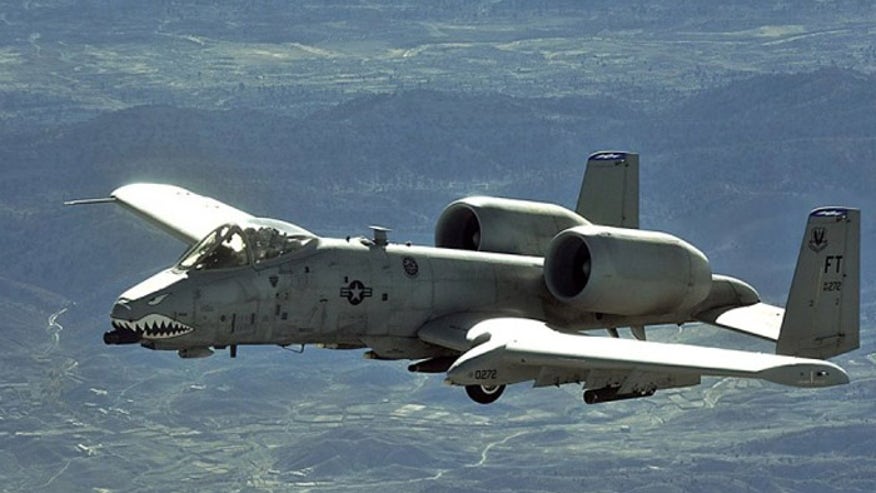
The A-10 flies low, needs little maintenance, an scares the
heck out of ISIS, according to a recent report. (USAF)
The venerable plane, first built for destroying Soviet tanks, has been on the chopping block since the sequester of 2011 mandated steep cuts in the Pentagon budget. Although the planes haven't been built in more than 30 years, the Defense Department believes it can save maintenance costs by phasing them out. Air Force brass believes newer, faster aircraft like the F-16, F-15E, and, eventually, Lockheed Martin’s F-35 fighter can do a better job of the Warthog’s mission of providing close air support to soldiers on the ground. But supporters say Islamic State fighters are finding out the hard way what they have said all along.
“The aircraft sparked panic in the ranks of ISIS after bombing its elements and flying in spaces close to the ground.”The plane is not as fast and lacks the graceful lines of other fighter jets. But the Warthog, as pilots call it due to the snout-like nose, is extremely low maintenance, flies low, can practically hover over a battlefield, land almost anywhere and packs a 20-foot-long, 2.5-ton, seven-barrel Gatling gun that can fire more than 1,100 rounds of 30-mm. bullets. And a titanium shell that wraps around the bottom of its cockpit makes it difficult to shoot down.
- Iraqi News
In Iraq, the A-10 has flown 11 percent of the sorties against ISIS, Air Force Secretary Deborah Lee James said on Jan. 15. But that figure is deceptive, because the A-10 was not deployed until mid-November, some three months after strikes against ISIS began.
"There are a number of strike platforms, of course, that are engaged in it," James said. "[The] A-10 is one of it, but there's also F-16s, F-15s, and so forth. They're each contributing."
The Air Force has been itching to junk the plane for years, with some speculating that top brass believes the A-10 bucks the embraced strategy of high-altitude strategic bombing. The Pentagon believes it can save $4.2 billion in operation and maintenance costs over five years by retiring all 283 of the Air Force’s A-10s, the last of which rolled off Fairchild Republic’s assembly line in 1984.
The plane has survived year-to-year, with powerful lawmakers such as new Senate Armed Services Committee Chairman John McCain, R-Ariz., fighting to keep it alive. Loyalists have even established a Facebook page, dubbed "Save the A-10." Now, it is likely the A-10, spared retirement in fiscal 2015, will gain more support with McCain’s ascent and its battlefield success in Iraq.
“The A-10 is once again displaying its incredible utility and value against the Islamic State," a Senate Armed Services Committee aide told FoxNews.com. "The Air Force’s employment of the A-10 in ongoing operations not only underscores the operational effectiveness of this remarkable weapons system, but also of the necessity to maintain sufficient fighter force capacity at appropriate readiness levels to respond around the world on short notice.”
And McCain has wing support from fellow Republican Sen. Kelly Ayotte, N.H. She also serves on the powerful committee and her husband flew the A-10 on combat missions in Iraq.
“I’m in for this fight,” Ayotte said recently when asked about keeping the Warthog alive,
http://www.ibtimes.com/
An unexpected appearance by the brutish-looking aircraft at the glitzy Paris Air Show this week showcased the return to the spotlight of the Warthog, as it's universally known by its crews. Not only has the A-10 found a new lease on life fighting Islamic State group militants in Iraq and Syria, and being deployed to its old hunting grounds in Eastern Europe to deter Russian hostility -- it's now being touted by Boeing as a great aircraft for customers in the Middle East, who would get modernized airplanes dismissed by the U.S. Air Force, which has about 300 left in service.
Any deal, however, will only happen if the aircraft is retired under proposed plans by the Air Force, according to Paul Cejas, chief engineer for off-Boeing programs in the company's support division, who said that the idea to sell the A-10 to new customers “is fairly new and not at a point where we can provide more details." Only the United States has ever operated the plane, a slow and ungainly but heavily armed jet that excels at destroying armored targets on the ground. It was made to hunt Soviet tanks in Europe, a role it never performed in real life, finding instead a new job as a specialized platform for supporting troops on the ground in close combat.
Boeing, which took over from the original manufacturer, Fairchild Republic, which went out of business in the 1980s, is currently fulfilling a contract to provide 173 sets of new wings to the remaining A-10 fleet. So far, it has delivered 105 sets and doesn't expect the remnant to be canceled even if the Air Force retires the aircraft or reduces the fleet size. According to Aviation Week, the new wings will return many of the A-10s to so-called "zero-time condition," meaning they are like new.
Cejas also says that fitting the aircraft with a new engine was also on the agenda, as the current one has not changed since the 1970s. Boeing has a number in the same thrust class available. Other upgrades could include a new targeting pod and a helmet-mounted display system.
Talks of an upgrade are a far cry from the debate in Congress around the A-10 that was happening in recent years; the jet was almost retired, and only the political weight of supporters like Senate Armed Services Committee chairman John McCain and fellow Republican Sen. Kelly Ayotte managed to save it. The aircraft has so far survived budget cuts due to the so-called sequestration process; the Air Force has proposed several times to cut it, beginning in 2012, to save an expected $4 billion over five years and help pay for the new F-35.
Air Force chiefs contend that the incoming F-35 would be able to perform the same close-air-support role as the A-10, and that they needed to divert maintainers from the A-10 to F-35 sooner than later in order to familiarize them with the new systems. So far Congress has not seen it the same way, and in negotiations for the 2016 defense budget it appears that the current fleet of Warthogs will be kept fully intact.
Plus, recent deployments to Syria and Iraq to fight the Islamic State group have strengthened the case for keeping the aircraft. Its ability to fly at low altitude and pick off very specific targets has been key when hitting militants fighting in semi-urban areas. High-flying fighter jets are not capable of the same response to shifting conditions on the ground or accuracy at close range, according to A-10 supporters. That may be the core of the sales pitch that Boeing could make to potential new clients.
Billed as a “low-cost counterterrorism” system, the modernized A-10 is clearly being aimed at Middle Eastern customers, who are likely to be interested in such an aircraft given the rise of ISIS in the region. The United Arab Emirates and Saudi Arabia may be two of the likely buyers, according to industry sources that cite Boeing’s close relationship with both.
In addition, and bringing the aircraft full circle to its Cold War roots, it is has been deployed to Romania and Germany in an attempt to deter Russian hostility in Eastern Europe.

The
B-52 has only been able to carry smart weapons on its external pylons,
with its internal weapons bay being relegated to nuclear and dumb bombs,
as well as some older cruise missiles. Now, the iconic 60 year old
Stratofortress is finally getting a new 'smart' rotary weapons rack and
other upgrades that will more than double its smart weapons punch.

You could say that the B-52's
empty weapons bay has been the most under-utilized real estate in the
entire USAF. Even as the B-52's utility morphed over the decades (from a
nuclear interdiction option, to a carpet bomber, to a nuclear cruise
missile carrier, to a conventional cruise missile carrier, to a smart
bomb lobber, to a precision close air support platform) the big bomber's
cavernous belly has become more and more of an empty afterthought.

Although
having the B-52 lug its smart bombs on its large inboard weapons pylons
has not kept it out of the fight, this configuration has hurt the gas
guzzling behemoth's fuel economy and range and has left great potential
on the table, especially in an age of anti-access warfare and advanced standoff weaponry.

For almost a decade and a half, the USAF's B-52Hs have delivered GPS guided Joint Direct Attack Munitions and laser guided bombs
from their perches high above the Hindu Kush Mountains and the deserts
of Mesopotamia, acting as arsenal ships for ground forces tens of
thousands of feet below. And on almost every one of these missions their
bellies were empty.
The B-52's
internal weapons bays and weapons racks were never wired for modern
munitions. The all-important 1760 Aircraft/Store Electrical
Interconnection System, which allows the crew to program modern weapons
in flight, came long after even the B-52s AGM-86 Air Launched Cruise Missiles were put into service. This is finally changing, with a program called the "1760 Internal Weapons Bay Upgrade."
This
upgrade will see the B-52H's old cruise missile racks rebuilt and
rewired to 1760 data-bus electronic interface standards. These
revitalized rotary weapons racks are called Conventional Rotary
Launchers (CRL) and they are currently being tested with the 419th
Flight Test Squadron at Edwards AFB.

Under the
first phase of this upgrade, the Conventional Rotary Launcher will be
able to hold 24 GBU-38 500lb JDAMs or a whopping 20 of the GBU-31
2,000lb JDAMs. Laser guided JDAMs and other smart gravity and glide
bombs will follow soon after. Yet short-range weapons will not be the
CRL's only claim to combat fame. Soon, the launcher will be able to
sling gobs of stand-off weapons such as the stealthy AGM-158 Joint Air-to-Surface Standoff Missile (JASSM) and the very guileful Miniture Air Launched Decoy Jammers (MALD-J).
What this means is that a single B-52H could fly thousands of miles
around the globe, approach the outer edge of an enemy's air defenses and
let loose a full on barrage of stealth cruise missiles and smart cruise
decoys, then turn around to cruise back to base for more weapons and a
new crew.
Think of it as a very smart kamikaze air force in a box, or, well, a bomb bay.

Such a
capability lends credence to the fact that advanced standoff weaponry
can take the place of expensive manned platforms when it comes to the
first days of war against a credible enemy. This mindset has been
growing since the 1970s and the B-52 is now turning into the flexible arsenal ship that has been proposed in various forms over the years.
Yet, even with a manned force pushing an attack into highly defended
enemy airspace, the B-52 could fill its belly and external hardpoints
with gobs of MALD-Js, basically acting as a mothership for a fake aerial
invasion force, one that will distract, disrupt and the blind the enemy
from detecting the real strike force.

The USAF
and Boeing team behind the BUFF's (Big Ugly Fat Fucker is the B-52's
humble nickname) weapons bay upgrade say that soon a single Conventional
Rotary Launcher will be able to hold multiple types of munitions, which
will allow mission planners and weaponeers to pick the perfect cocktail
of weaponry for a given mission or target set. For instance, a B-52H
assigned to close air support duties may have its CRL loaded a third
full of 500lb laser JDAMs, a third full of large 1,000 JDAMs and the
rest filled with deadly CBU-105 Sensor Fused Weapons.
In the
future, a B-52 assigned to anti-ship/littoral warfare targets may sport
half a rack of stealthy JASSMs, for hitting key port facilities, while
the other half is full of the JASSM's stealthy anti-ship missile cousin,
the Long-Rang Anti Ship Missile (LRASM),
used for hitting ships guarding the port itself. Basically, a handful
of B-52s loaded out in such a fashion could destroy an enemy's strategic
port facilities and nearby combat ships without ever even traveling
within range of the enemy's air defenses.

Alongside
the B-52s weapons bay upgrade, the BUFFs will also be getting a new
satallite communications and data-link system known as Combat Network
Communications Technology, or CONECT for short. This system will allow
B-52 crews to get mission updates and detailed re-tasking orders while
they are already on the way to their targets. This will make the B-52 a
reactive, tactical weapon system instead of more of a strategic one.
CONECT will also be paired with a new windows-based mission planning
software and interface for the crew to use so that they can re-plan
missions on the fly based on new targeting or threat info sent to them
via CONECT or collected by their own and third party sensors.

Such a
system will make the deadlier BUFFs much more effective in a modern
'netcentric' battlespace. For instance, let's take the aforementioned
mission where a flight of B-52s are tasked with taking out an enemy's
port facilities and the ships that guard it as an example. As the B-52s
are five hours out from their launch points, radar, signals and image
intelligence collected by a stealthy High-Altitude Long-Endurance unmanned aircraft, orbiting
at 70,000 feet and 100 miles from the targeted port in question,
detects a string of ships leaving the port and classifies them as enemy
surface combatants. Commanders on the ground receive this data and
immediately re-task the inbound B-52s to attack the flotilla, not the
lower priority port which is now empty.
The B-52s
can continuously receive updates from the high-flying UAV as to the
flotilla's coordinates so that they can reprogram their LRASM anti-ship
missiles. By the time the B-52s arrive within launch range, the enemy
ship formation is now 120 miles south of the originally targeted port.
Another enemy port is now within closer sailing distance of the enemy
flotilla, and commanders on the ground think that any of these enemy
ships that can still make their own way once the LRASMs have done their
job will try to enter that port for safety and repairs. As a result, the
B-52s are ordered to retarget their JASSMs at a long bridge that spans
the narrow entry into this port in hopes of denying these enemy ships
entry. This will also leave them sitting ducks for follow-on attacks.

A few
hundred miles from their new targets, now far south of the originally
targeted port, the B-52s receive final coordinates from the stealth UAV
and space-based systems that are tracking the flotilla. The B-52s ripple
off their anti-ship missiles along with a handful of MALD-J decoys to
play havoc on the flotilla's radar and communications systems. The
B-52s, now with half their stores gone, are now under the cover of F-22
Raptor's launched from an island base 1,000 miles away and supported by a
'tanker bridge' to the battlespace and back. The B-52 crews wait to
hear the assessment of their attacks while under the Raptor's protective
umbrella.
The HALE
stealth drone reports that only five radar signatures out of a dozen and
half that were moving at high-speed before the missiles arrived on
target continue to move, those that are not moving are also showing a
heavy infrared signature. They are on fire. Those five enemy ships that
survived the initial LRASM attack are moving at high-speed to the
nearest port, just as commanders on the ground had guessed.

The B-52s
only have 30 minutes of fighter escort before the F-22s have to return
to the tanker, so they rapidly put their pre-programmed plan into play,
rippling off their JASSMs at the bridge in question. They then turn
towards friendly airspace with their F-22s escorts. Within two hours a
report comes through the B-52's CONECT terminal showing satellite
imagery depicting the targeted bridge, at least what is left of it, its
span having dropped in the channel, blocking transit of the surviving
ships into the enemy's port.
Meanwhile,
as the original B-52 attack force is safely on their way back home,
another stream of backup B-52s are making their way toward their newly
programmed targets. Originally, they had the same target list of the
first attacking force, but like it, the follow-on B-52 assault force has
had their plan changed on the fly. This time, their primary targets are
a handful of enemy surface combatants sitting idle by a port whose
entrance is blocked by a dropped bridge-span, along with the port's
facilities, including a large fuel farm and drydock. The Raptors will be
back to cover their attack once they refuel, just as they did with the
first group of B-52s.
This
is just a snapshot of the fluid nature of air warfare in 21st century,
where one of the most deadly and effective weapons remains the oldest
jet flying in active USAF service. It also reminds us of this antique
bomber's latent potential. Other upgrades could bring new efficiency and
capabilities to the long paid-for jets. New engines, a large AESA radar system, standoff jamming arrays, the ability to carry throngs of small diameter bombs
and other upgrades could continue to pump new life into the geriatric
bombers, bringing their planned end of service date into doubt.
In
the end the B-52 could become so deadly, tactically agile and relevant
that it could live well past its 100th birthday, continuing towards the
latter half of the century as America's go-to weapons and sensors truck.
Its long awaited internal smart bomb rack and updated satellite
communications system maybe just the beginning of the BUFF's powerful
second wind.

Photos/Source via DoD
Tyler
Rogoway is a defense journalist and photographer who maintains the
website Foxtrot Alpha for Jalopnik.com You can reach Tyler with story
ideas or direct comments regarding this or any other defense topic via
the email address Tyler@Jalopnik.com


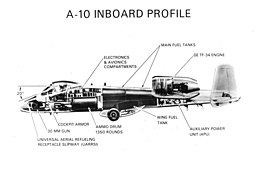







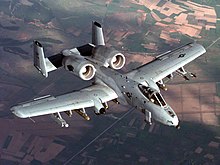







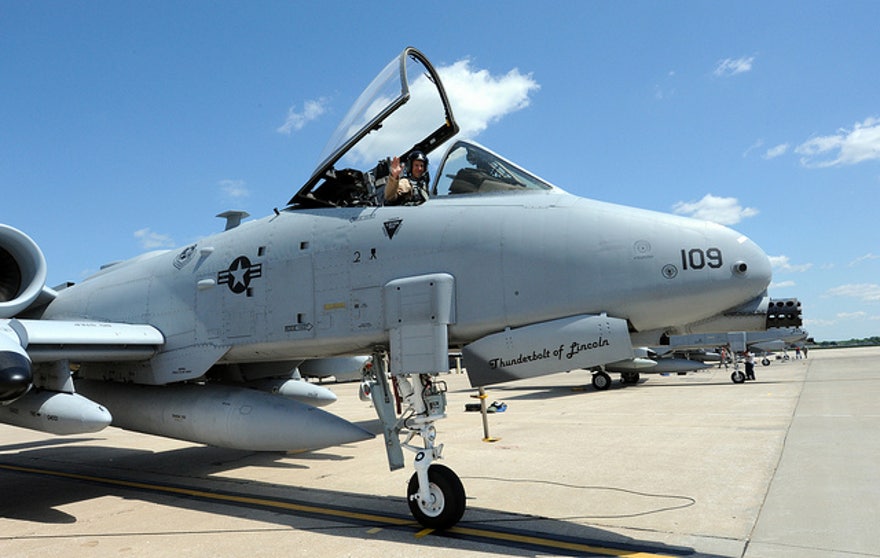
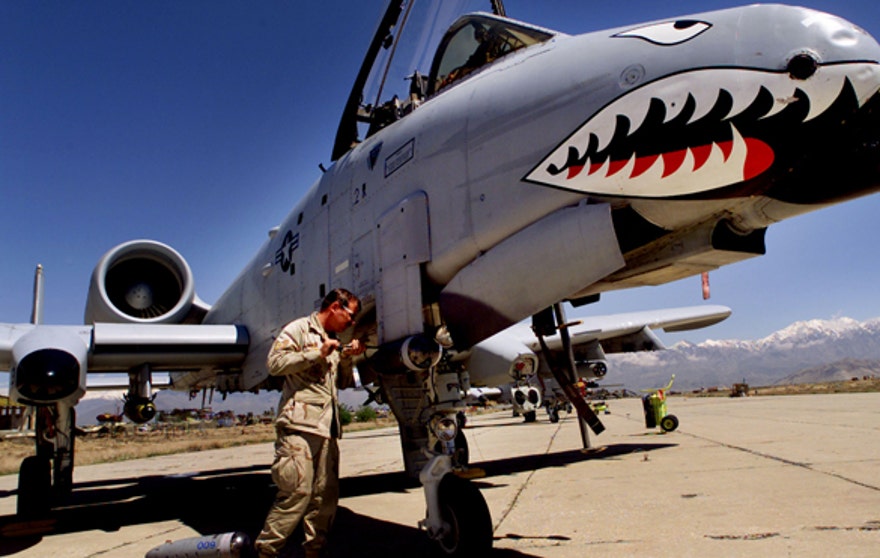

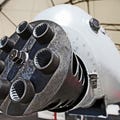





No comments:
Post a Comment